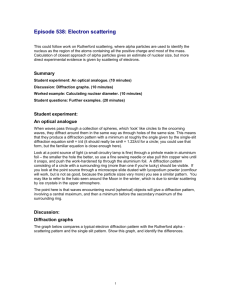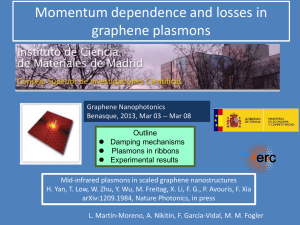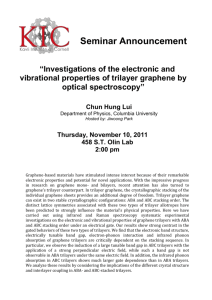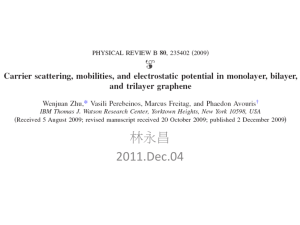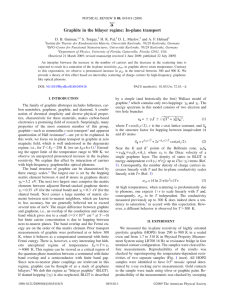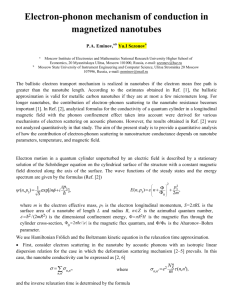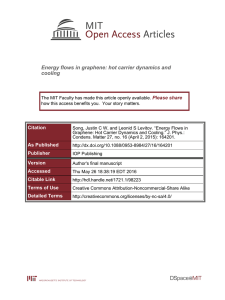Allen_DWF_JAP_SI_revision1
advertisement
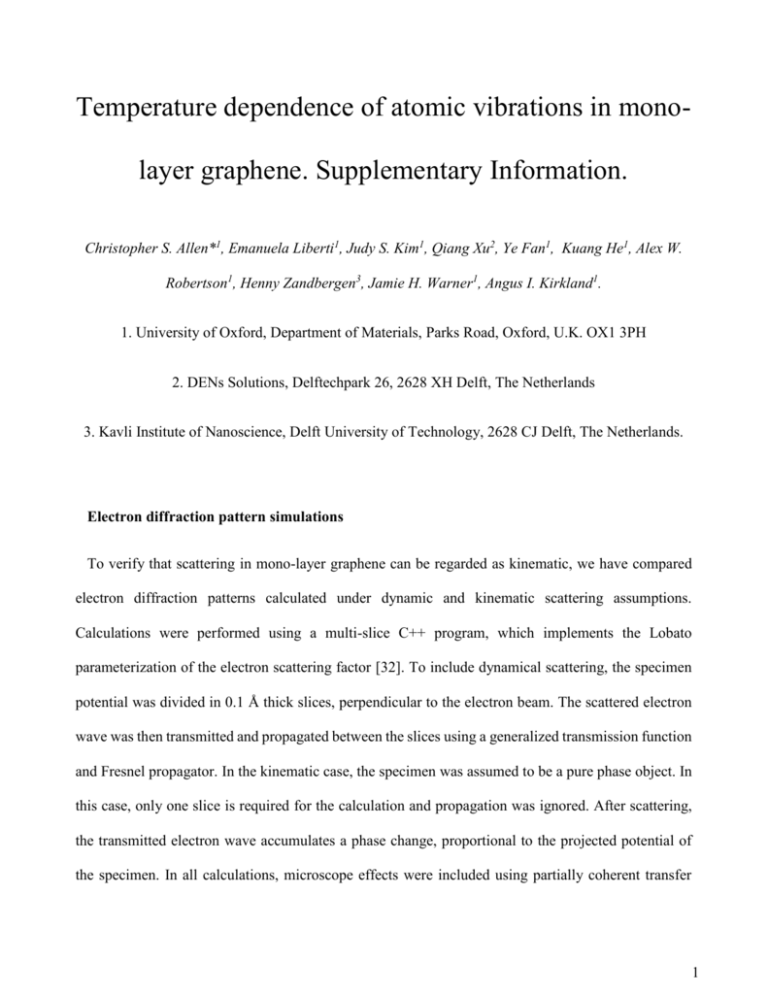
Temperature dependence of atomic vibrations in monolayer graphene. Supplementary Information. Christopher S. Allen*1, Emanuela Liberti1, Judy S. Kim1, Qiang Xu2, Ye Fan1, Kuang He1, Alex W. Robertson1, Henny Zandbergen3, Jamie H. Warner1, Angus I. Kirkland1. 1. University of Oxford, Department of Materials, Parks Road, Oxford, U.K. OX1 3PH 2. DENs Solutions, Delftechpark 26, 2628 XH Delft, The Netherlands 3. Kavli Institute of Nanoscience, Delft University of Technology, 2628 CJ Delft, The Netherlands. Electron diffraction pattern simulations To verify that scattering in mono-layer graphene can be regarded as kinematic, we have compared electron diffraction patterns calculated under dynamic and kinematic scattering assumptions. Calculations were performed using a multi-slice C++ program, which implements the Lobato parameterization of the electron scattering factor [32]. To include dynamical scattering, the specimen potential was divided in 0.1 Å thick slices, perpendicular to the electron beam. The scattered electron wave was then transmitted and propagated between the slices using a generalized transmission function and Fresnel propagator. In the kinematic case, the specimen was assumed to be a pure phase object. In this case, only one slice is required for the calculation and propagation was ignored. After scattering, the transmitted electron wave accumulates a phase change, proportional to the projected potential of the specimen. In all calculations, microscope effects were included using partially coherent transfer 1 functions. Thermal vibrations were also included, by implementing the frozen phonon approach, which uses the Einstein model with 500 phonon configurations. The Debye-Waller factor was taken to be the experimental value determined from the analysis of the diffraction patterns. A numerical real space grid of 4096 x 4096 pixels was used for a super cell size of 60 x 60 Å (14 x 8 units in sample box), corresponding to a sampling resolution of 0.015 Å/pixel. a. b. Supplementary Figure 1. Total number of counts as a function of scattering angle for peaks extracted from diffraction patterns simulated for (a) kinematic and (b) dynamical scattering. The red lines show fits to (1). Supplementary figure 1 shows fits of (1) to the kinematic and dynamic diffraction simulations using the approach described in the main text. At 313 K we calculate identical values for the in-plane displacements for dynamical and kinematic scattering. At T = 1273 K, corresponding to the highest 2 experimental temperature studied, we have found that the in-plane displacements calculated using the phase object approximation and using a full multi-slice calculation differ by only 0.2 pm, below the error in our experimentally measured values. We therefore conclude that electron scattering from mono-layer graphene can be regarded as kinematic across the temperature range pertinent to the experiments described. Supplementary Table 1: Temperature dependence of 𝑢𝑝2 Temperature (±30 K) 𝑢𝑝2 (pm2) 103 15 ± 3 293 13 ± 4 313 15 ± 1 373 16 ± 1 473 19 ± 2 573 24 ± 2 673 24 ± 2 773 30 ± 2 873 30 ± 2 973 32 ± 2 3 1073 39 ± 2 1173 40 ± 2 1273 42 ± 2 Supplementary Figure 2. Temperature dependence of the planar (𝑢𝑝2 ) mean square displacements for four different mono-layer graphene samples (all prepared using the procedure outlined in [17]). 4 Supplementary Figure 3. High resolution TEM image of pristine mono-layer graphene recorded at ∼1070 K. At temperatures in excess of ≳ 800 K the graphene surface is largely free of contamination. Derivation of 𝒖𝟐𝒛 The mean square atomic displacement can be written [33] 𝑢𝑧2 = 1 ∑⟨(𝒖𝑠 (𝒌))2 ⟩ 2𝑁 𝒌,𝑠 with ℏ 𝒖𝑠 (𝒌) = 𝜺𝑠 (𝒌)√ (𝑐 (𝒌) + 𝑐𝑠† (−𝒌)) 2𝑀𝜔𝑠 (𝒌) 𝑠 giving 𝑢𝑧2 = ℏ 1 𝜀𝑠 (𝑘)2 1 ∑ [𝑛(𝜔(𝑘)) + ] 2𝑀 𝑁 𝜔(𝑘) 2 𝑘,𝑠 As there is only one phonon branch for flexural phonons in mono-layer graphene: ∑ 𝜀𝑠 (𝑘) = 1 𝑠 5 Writing the sum over all 𝒌 states as an integral over spatial (𝑝) and momentum (𝑞) co-ordinates (two dimensional Bohr-Somerfield): 𝜕 2𝑝 𝜕 2𝑞 ∑=∬ ℎ2 𝑘 gives 𝑢𝑧2 = ℏ 1 𝜕 2𝑝 𝜕 2𝑞 1 1 1 ∬ [ + ] 2 2𝑀 𝑁 ℎ 𝜔(𝑘) exp(𝛽ℏ𝜔(𝑘)) − 1 2 Further, assuming a quadratic dispersion for flexural phonons in mono-layer graphene: 𝜔(𝑘) = 𝛼𝑘 2 with 𝛼 = 6.2 × 10−7 m2/s. Noting that ∫ 𝜕 2 𝑝 is simply an area, 𝐴 (in 𝑘 space) and converting to polar co-ordinates, (i.e.∫ 𝜕 2 𝑞 = ℏ𝑘𝑑𝑘𝑑𝜃 ) gives 𝑢𝑧2 = 𝜎 −1 ℏ 1 1 𝑑𝜃𝑑𝑘 1 1 ∫ 2 [ + ] 2 2 2𝑀 (2𝜋) 𝛼 𝑘 exp(𝛽ℏ𝛼𝑘 ) − 1 2 with 𝜎 the density of states 𝑁/𝐴 and 𝛽 = 1/𝑘𝐵 𝑇. 2𝜋 Evaluating the polar integral ∫0 𝑑𝜃 = 2𝜋 and writing 𝑥 = 𝛽ℏ𝛼𝑘 2 (giving 𝑑𝑥 = 2𝛽ℏ𝛼𝑘 𝑑𝑘) gives 𝑢𝑧2 = 𝜎 −1 ℏ 𝑑𝑥 1 1 ∫ [ + ] 8𝑀𝜋𝛼 𝑥 exp(𝑥) − 1 2 For phonons in two dimensions 𝑘𝐷2 𝜎= 4𝜋 where 𝑘𝐷 is the Debye wave-vector. As in the case for planar phonons we introduce a smallest phonon wave-vector 𝑘𝑠 in order to avoid the divergence of the function at any finite temperature. This analysis finally yields (7) 𝑥 1 ℏ 1 1 𝑢𝑧2 = 2𝑀𝑘 2 𝛼 ∫𝑥 𝐷 𝑥 [exp(𝑥)−1 + 2] 𝑑𝑥 𝐷 𝑠 for which there is no analytical solution to the integral which must therefore be solved numerically. 6


